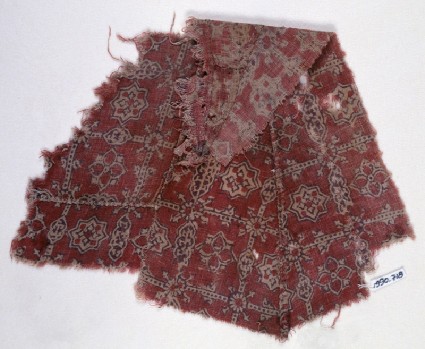Browse: 10610 objects
- Reference URL
Actions
Textile fragment with quatrefoils and stars, probably from a garment
-
Details
- Date
- 2nd half of the 10th century - 15th century AD
- Material and technique
- five pieces of cotton, block-printed with mordant, and dyed red and brown; joined with flat seams in flax
- Dimensions
- Material index
- Technique index
- Object type index
- No. of items
- 1
- Credit line
- Presented by Professor Percy Newberry, 1941.
- Accession no.
- EA1990.718
-
Further reading
Barnes, Ruth, Indian Block-Printed Textiles in Egypt: The Newberry Collection in the Ashmolean Museum, Oxford, 2 vols (Oxford: Clarendon Press, 1997), no. 711 on pp. 209-210 (vol. ii), vol. ii p. 210, illus. vol. ii p. 209 fig. 711 & vol. i pl. 25
Location
-
-
First floor | Room 30 | Mediterranean

-
First floor | Room 30 | Mediterranean
Objects are sometimes moved to a different location. Our object location data is usually updated on a monthly basis. Contact the Jameel Study Centre if you are planning to visit the museum to see a particular object on display, or would like to arrange an appointment to see an object in our reserve collections.
© 2013 University of Oxford - Ashmolean Museum


